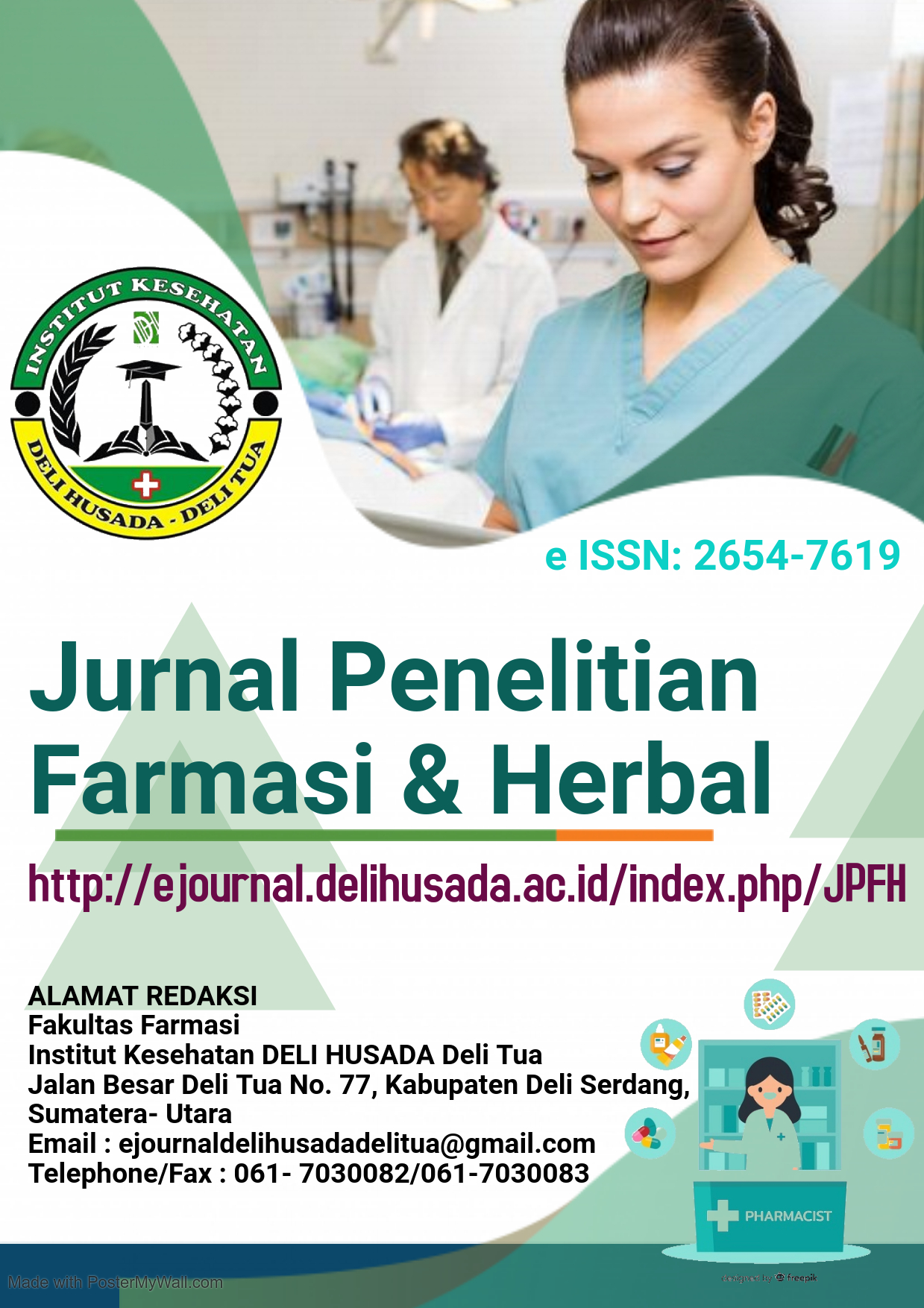FORMULASI DAN UJI KETAHANAN SEDIAAN PARFUM SPRAY BUNGA LILI ( Lilium longiflorum)
Abstract
This study aimed to formulate and evaluate the fragrance longevity of lily flower (Lilium longiflorum) spray perfume. Lily essential oil was extracted using steam distillation and formulated at concentrations of 5%, 10%, and 15% with additional fixatives, solvents, solubilizers, and preservatives. Evaluations included organoleptic tests, density, pH, fragrance longevity, stability, and aroma preference. Results showed that all formulations had good clarity, homogeneity, and skin-safe pH values (5.29–5.55). Formula 2 (10%) provided the best balanced fragrance intensity and received the highest preference score from panelists. The longest fragrance retention was achieved by Formula 3 (15%), though its intensity was considered too strong. In conclusion, lily essential oil spray perfume can be formulated stably with adequate fragrance longevity, showing potential as a competitive natural perfume product.
Downloads
References
Gunawan, I., & Rahayu, P. (2021). Formulasi dan Evaluasi Parfum Tipe Eau de Toilette (EDT)“Senarai Jingga.” Jurnal Kesehatan, 12(2), 257–265.
Herdianto, E., Sihabudin, S., & Saepudin, S. (2022). Sistem pendukung keputusan pemilihan merk parfum pada wanita menggunakan metode ahp. Jurnal Riset Sistem Informasi Dan Teknologi Informasi (JURSISTEKNI), 4(3), 99–105.
Itamar, S., Fadhallah, E. G., & Al Rasyid, H. (2023). Formulasi Minyak Atsiri (Essential Oil) Cengkeh (Oleum syzygium aromaticum) pada Pembuatan Eau de Parfum. Inovasi Pembangunan-Jurnal Kelitbangan, 11(2), 211–226.
Johnson, T. S., Schwieterman, M. L., Kim, J. Y., Cho, K. H., Clark, D. G., & Colquhoun, T. A. (2016). Lilium floral fragrance: a biochemical and genetic resource for aroma and flavor. Phytochemistry, 122, 103–112.
Kurniasari, F., Darmayanti, N., & Astuti, S. D. (2017). Pemanfaatan Aromaterapi Pada Berbagai Produk (Parfum Solid, lipbalm, dan Lilin Anti Nyamuk). ACEPLAY99 Hari Ini: Server Terbaik Dengan Winrate Tinggi Di Slot Thailand, 1(2), 13–17.
Kurniati, R., Marwoto, B., Silvia, E., & Fibrianty, E. (2021). Evaluasi dan Seleksi Ketahanan Lili Hasil Induksi Mutasi Kimia terhadap Fusarium oxysporum f. sp. lilii (Evaluation and Selection for Resistance to Fusarium oxysporum f. sp. lilii in Lily). Jurnal Hortikultura, 31(2).
Lestari, N. K. D., Deswiniyanti, N. W., Astarini, I. A., & Arpiwi, L. M. (2019). Callus and shoot induction of leaf culture Lilium longiflorum with NAA and BAP. Nusantara Bioscience 11 (2): 162-165.
Lestari, U. P., Kusala, K. V., Chairunnisa, M., Wahyuni, Rahayu, T., & Harismah, K. (2023). Formulasi Kombinasi Minyak Nilam (Pogostemon cablin), Minyak Adas (Foeniculum vulgare) dan Aroma Buah untuk Pembuatan Parfum. Simposium Nasional RAPI XXI – 2023 FT UMS, 274–279.
Maesaroh, I., & Fahmilik, L. (2021). Formulasi Dan Evaluasi Sediaan Spray Gel Ekstrak Bunga Marigold (Tagetes Erecta L) Sebagai Antioksidan. Jurnal Komunitas Farmasi Nasional, 1(1), 26–37.
Siswantito, F., Nugroho, A. N. R., Iskandar, R. L., Sitanggang, C. O., Al-Qordhiyah, Z., Rosidah, C., Nurhayati, S., & Sari, D. A. (2023). Produksi minyak atsiri melalui ragam metode ekstraksi dengan berbahan baku jahe. Jurnal Inovasi Teknik Kimia, 8(3), 178–184.
Subiya, A. T., & Wijaya, F. (2024). Formulasi Perancangan Strategi Pengembangan Usaha Pada Avelina Parfum. Jurnal Ilmu Sosial, Manajemen, Akuntansi Dan Bisnis, 5(2), 257–270.
Surbakti, C. I., & Swadana, E. (2018). Formulasi sediaan pengharum ruangan dari minyak melati dengan minyak akar wangi sebagai pengikat. Jurnal Farmasimed (JFM), 1(1), 6–10.







